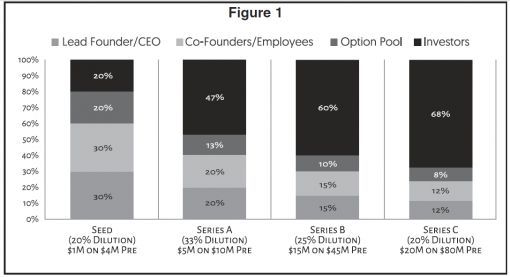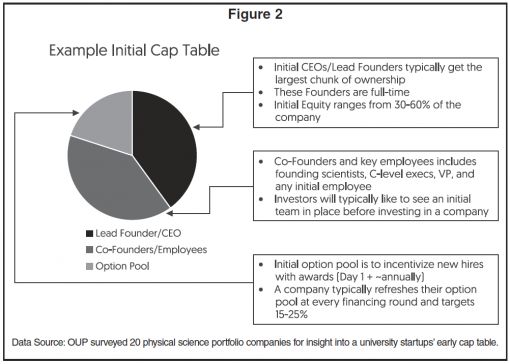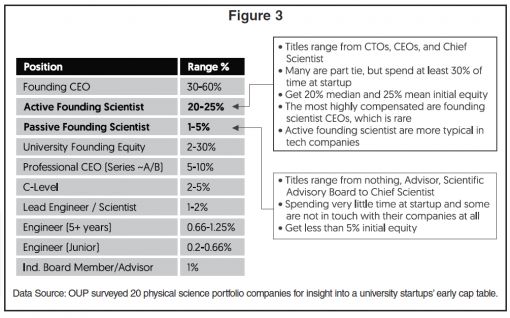When hiring venture executives and employees in the early stages of a university start-up, the buzz centers around equity. For successful ventures, these equity rights, often issued when the equity is worth pennies a share, hold the potential of delivering great wealth to those fortunate enough to receive them. However, there is an often ignored drawback to equity compensation — simply stated, it is the credit card of the venture world. As opposed to salaries that directly impact budgets, equity grants are "painless" and only upon exit of the venture does the true cost of the grants become apparent.
The painlessness of equity grants makes it a very tempting compensation tool for cash-strapped early-stage start-ups. But these ventures often risk making outsize equity grants to employees who, while important in the short term, will not have a significant long-term impact on the company. Many ventures fail to recognize that equity needs to be budgeted and, as a result, "spend" too much too early, leaving less available for additional grants to round out the leadership team and make other critical hires.
For university spinouts that often need to hire a large part of their future executive teams, mistakes in early equity grants can unnecessarily dilute founders' and university's common stock positions.
To understand the impact of dilution on a founder's stake, Figure 1 shows a hypothetical ownership summary that reflects typical ownership through financing rounds and how the dilution plays out. As the figure shows, while the nominal value of the founder's stock is increasing, even in a successful venture, the founder's ownership percentage declines steeply as a result of dilution. In the hypothetical, the company has raised a total of $41 million in four funding rounds. Each of the funding rounds represented an "up round" where the pre-money represented a significant increase from the post-money valuation of the prior round. Yet the founders' share dropped from 30% to 12% — in other words, a smaller piece of a larger pie.
The average successful tech start-up exits for $240M after a series of raises totaling approximately $40M of capital. This amount of capital is typical of the industry, and it is distinct from the need to refresh the start-up's option pool across each financing.
The purpose of raising capital can be evaluated across three categories that fuel a start-up engine into wild success: 1) value inflection; 2) employee compensation; and 3) growth. Venture investment is a double-edged sword: by accepting investment, a founder loses control and ownership; but without investment that same founder cannot feed the engine that creates value. Driving a start-up through a value inflection point can be achieved through both quantitative and qualitative milestones, but it should be simply thought of as the means by which a $1M investment can create a large valuation uptick in a subsequent fundraising round. In most companies, employee compensation is the largest expense, and certain skillsets and geographies garner surprisingly high salaries. Lastly, fueling growth with investment capital is the tool that allows companies to expand their team, footprint, facilitation, and marketing.
In the typical funding and exit described in the hypothetical, the founders, founding team, and employees were diluted over time. While 12% of a $240M exit is definitively a life-changing event, the path to even larger personal upside can only be achieved by reducing dilution and increasing valuation.
The dilution equation is simple ($-raised/$-valuation), but the implications of driving the numerator to $0 or the denominator to unicorn status is much more nuanced. When founders are building their cap tables, they should think about how taking more dilution will ultimately create a bigger pie to take a slice of down the road. For founders and their university tech transfer partners, this dilution can be exacerbated by poor choices in equity grants to employees.
Holistic approach to compensation
Ideally, employee compensation should address three goals — recruitment, performance and retention. When on-boarding employees, ventures have several economic "levers" at their disposal, each of which serves as a different form of incentive. While the true cost of equity grants is often deferred to exit, ventures should balance these levers to achieve the goals of compensation, while minimizing the size of dilutive equity grants. A company's primary levers are:
- Base Compensation — Start-ups typically can pay less than their established peers because of the equity compensation usually provided. However, it is important that this compensation be competitive with other start-ups in the same geography and that it meets the basic "living wage" requirements of recruits.
- Benefits and Perks — This is often where ventures try to distinguish themselves in recruiting. Ping pong tables, beer on tap, gym memberships, etc. are viewed as relatively inexpensive ways for ventures to set themselves apart. However, these benefits can add up to substantial sums of money and are typically the first things eliminated by struggling ventures.
- Bonuses — Less common for early stage companies (except for sales professionals who often work on a partial commission basis), bonuses are very effective in driving employees towards discrete, shorter term goals. It is critical that the basis for the payment of a bonus or commission and the timing of the payment is clearly laid out.
- Equity — Granting equity to employees and other service providers has two main goals. First, it creates long term alignment since all recipients are incentivized to increase the value of the company as a whole rather than meet narrow metrics. Second, since equity is often granted subject to multi-year vesting, it creates a cost for leaving the company which serves as a form of golden handcuffs.
A more detailed look at equity
Equity grants can take several forms, the most common forms are:
- Stock Options (Incentive Stock Options (ISOs)/Non-Qualified Stock Options (NQOs/NSOs) — Employees are given the option of purchasing common shares of the company upon the payment of an option strike price equal to the fair market value of the stock at the time of grant.
- Restricted Stock Awards — These are actual grants of shares in the company, usually subject to a company repurchase option (reverse vesting) and transfer restrictions. These grants are taxed immediately as income and as a result, they are usually made only when the granting company has minimal value.
- Restricted Stock Units — These units are issued to an employee through a vesting plan after remaining with their employer for a particular length of time. RSUs give an employee an interest in company stock but they have no tangible value until vesting is complete. The value of the stock received at the completion of vesting will be taxed as ordinary income.
- Stock Appreciation Rights — The recipient is not actually given shares. Instead the recipient receives a contractual obligation from the employer to make a payout equal to the value of the appreciation of a specified number of shares upon the occurrence of a specified event or the passage of a specified period of time.
(Editor's note: For a chart that describes each form of equity grant in greater detail, please go to https://rimonlaw.com/employee-equity.)
Options are the most common form of incentive for venture-backed companies. However, when company valuations are still low, restricted stock awards offer certain tax advantages. Restricted Stock Units tend to be granted more frequently by later stage companies. There are several concepts that apply to all equity grants:
- Tax "Clock". When it comes to equity grants, founders should be aware that they are working under a ticking tax clock. Assuming the company increases in value, its share price is increasing as well. This impacts both stock and option grants. If stock is granted to an employee, it must be reported as compensation to the employee. As a result, the employee will have an immediate tax liability upon receipt for the fair market value of the stock. The exercise price of a stock option has to be set at the then current fair market value of the stock or it may be considered deferred compensation under Section 409(a) of the tax code. Assuming the company is increasing in value, the longer a company waits to grant an employee option, the higher that tax will be for stock grants and the higher the strike price will be for options. Companies also have to be careful that stock/options are valued on the date the grants are actually completed. It is not uncommon for companies to delay formally documenting grants, and backdating grants can have serious legal consequences.
- Vesting. To achieve the goal of promoting employee retention, equity grants are usually subject to vesting. Vesting is implemented in different ways for stock grants and options, but the goal is the same — at the point where vesting ends, an employee leaving the company before the end of the vesting period will generally suffer an adverse consequence with respect to the unvested portion of the equity/options. Under certain circumstances, the adverse consequence is extended to vested shares.
Although there is no legally required vesting structure, the most common vesting structure is known as "4 years with a 1 year cliff." Under this structure, the shares remain unvested until the first anniversary, when 25% vests. The remaining 75% vests in equal monthly installments over the following three years. In situations where the employee has already worked a significant period of time before the grant of equity/options, a portion of the grant may be fully vested immediately.
Budgeting equity
So, how should a university start-up allocate equity across its founders? Figure 2 shows a breakdown of the typical initial founder's split in a physical sciences company. Figure 3 provides a more detailed breakdown of typical pre-financing equity compensation per employee level for a university spinout.
What is most noteworthy about this chart is the relatively small grants given to employees below the C-Suite level. These ranges should be kept in mind by ventures making grants to early hires. Even if a web designer is critical to the initial success of a venture and is willing to work for below-market wages, the individual has skills that in most cases are easily replaceable in the future. As a result, a grant of even 0.2% equity may be over-generous and unnecessarily deplete the equity budget.
On the other hand, the chart makes it clear that not all members of the management team are created equal. In most start-ups with two to four founders, there is often one charismatic leader who should be incentivized with a disproportionate share of equity. This Lead Founder/CEO typically receives the largest chunk of ownership, around 30-60%. If there is no CEO or lead in place, part of this piece would be set aside for a CEO who is brought on later. Co-founders and other key employees such as founding scientists, C-level executives, VPs, and initial employees should share in approximately 40% of equity allocation. The remaining ~20% option pool should be preserved for future hires. At each round of financing, the option pool should be refreshed (dilution!) to 15-20% until a full C-Suite has been hired. Employee options are issued throughout the lifecycle of the company to employees to fight against dilution. It is challenging to maintain employees at a high equity level throughout the course of a start-up, as there are few instances where you can significantly top off an employee's equity piece.
The Founding CEO is someone who intends to stay with the company over the long haul, carrying it from launch to exit. An Active Founding Scientist can be a principal investigator or graduate researcher who has developed the technology at a university, or a PI who bucks the norm and commits to taking leave from the university for two to three years. The Active Founding Scientist commonly assumes the role of CSO and CTO and leaves university for at least one year on sabbatical to work for the start-up full-time.
By contrast, a Passive Founding Scientist may only be involved once a week or once a quarter with the company. Very rarely, the Active Founding Scientist has the temperament and bandwidth to run as a founding/first/interim CEO, and should be rewarded with equity akin to Founding CEO. Despite their life's work being a part of the start-up's mission, most faculty fall into the category of Passive Founding Scientists, which typically should only be rewarded with 1-5% equity to create a clean cap table.
What is the value in having a founding scientist on the team and on the cap table, especially if his/her involvement would be limited? Once the founding scientists return to the university, their time is best spent on strategic efforts like hiring, R&D, or broad business relationships; assigning an operational role to a part-time employee would be unrealistic. Keeping a founding scientist on the cap table not only allows access to new developments in that lab in the related space, but more importantly to a pipeline of students from the lab. In addition, founding scientists often have high research connections with major companies that will trigger research collaborations and/or commercial agreements for the start-up. An affiliation with the university and high-profile researcher can help the company with fundraising and customers as well.
Not one-size-fits-all
Start-up compensation is not a one-size-fits-all proposition. It depends on many factors such as the financial situation of the venture and its future financing needs, the market for talent in which it competes, and the prospects — real or perceived — of the venture. What founders and other holders of common shares, such as universities [via their TTOs], need to keep in mind is that similar to credit card debt, poor use of equity has a cost — most of it borne by the common shareholders. Ventures should use all compensation tools at their disposal that create the right balance of incentives and current versus future costs.
Originally Published by Tech Transfer Central
The content of this article is intended to provide a general guide to the subject matter. Specialist advice should be sought about your specific circumstances.



